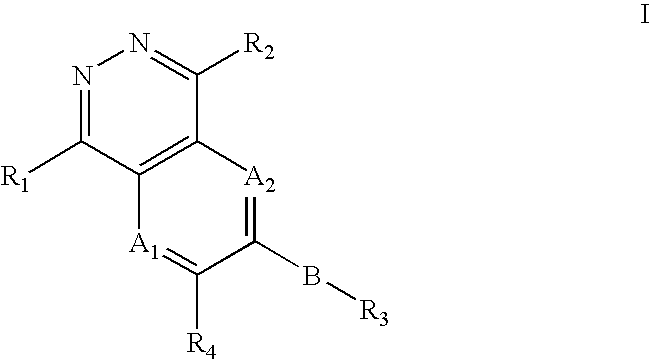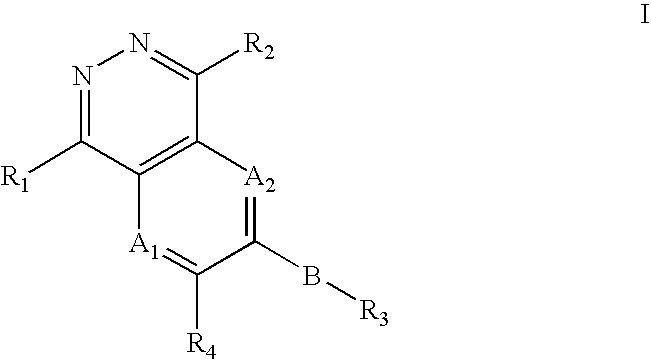Phthalazine compounds and methods of use
a technology of phthalazine and compounds, applied in the field of phthalazine compounds and methods of use, can solve the problems of small blood vessel adhesion and significant neutrophil accumulation in capillaries, and achieve the effect of prophylaxis and treatmen
- Summary
- Abstract
- Description
- Claims
- Application Information
AI Technical Summary
Benefits of technology
Problems solved by technology
Method used
Image
Examples
example 1
[0343]
Synthesis of 6-bromo-1-chlorolphthalazine (18)
[0344]Step A: A mixture of 4-bromo-2-methylbenzonitrile (14, 22 g, 112 mmol), benzoyl peroxide (2.7 g, 11 mmol) in 400 mL carbon tetrachloride was treated with n-bromosuccimide (21 mL, 247 mmol) at room temperature, then warmed up to 90° C. and stirred for 15 h. After 15 h of reaction, another 20 g of NBS was added and the reaction was stirred at 90° C. for another 10 h. Thin layer chromatography (TLC) revealed that all the starting material had been consumed. The reaction was cooled down to room temperature, filtered, and washed with hexane (100 mL). The filtrate was concentrated in vacou, and the crude product was purified via flash chromatography (silica gel) eluting with a gradient of 4 / 1 hexanes / EtOAc to 2 / 1 hexanes / EtOAc, to give as a white solid, 4-bromo-2-(dibromomethyl)benzonitrile 15, 29.6 g. Found MS (ES+): 354 (M+H)+.
[0345]Step B: To a solution of silver nitrate (AgNO3, 6.86 mL, 176 mmol) in water (200 mL) refluxed unde...
example 2
[0348]
Synthesis of 3-(1-hydroxyphthalazin-6-yl)-4-methylbenzoic acid
[0349]Step A: To a stirred suspension of 4-chlorobenzoic acid (31.3 g, 200 mmol) in toluene (200 mL) was added oxalyl chloride (30 mL, 350 mmol) followed by DMF (0.1 mL). The resulting suspension was heated at reflux until all solids dissolved. The solvent was removed under reduced pressure by rotary evaporation. The resulting semi-solid residue was dissolved in ethyl acetate (200 mL) and cooled in an ice bath under nitrogen with mechanical stirring. A solution of tert-butylamine (53 mL, 500 mmol) in ethyl acetate (50 mL) was carefully added to the mixture dropwise keeping the internal temperature below 10° C. During addition the initially clear solution became thick colorless slurry. Ethyl acetate (50 mL) was added followed by sat. aq. NaHCO3 (300 mL) and the resulting mixture was stirred until two clear layers resulted. The biphasic mixture was transferred into a separatory funnel, and the organic layer was separa...
example 3
[0353]
Synthesis of N-cyclopropyl-7-iodo-6-methylbenzo[d]isoxazol-3-amine
Step 1: 2-fluoro-3-iodo-4-methylbenzonitrile
[0354]A solution of 2,2,6,6-tetramethyl-4-piperidine (TMP) (45 mL, 267 mmol) in THF (400 mL) was cooled to −78° C. under an atmosphere of nitrogen. n-Butyl lithium (2.5 M in hexane, 110 mL, 275 mmol) was added slowly maintaining the temperature below −70° C. After addition, the reaction mixture was warmed to −50° C. and stirred for 30 minutes. The clear solution became turbid indicating the salt formation. The reaction mixture was recooled to −80° C., and a solution of 2-fluoro-4-methylbenzonitrile (32.4 g, 240 mmol) in THF (150 mL) was slowly added maintaining temperature below −70° C. The mixture was then warmed to −50° C. and stirred for 30 minutes. The mixture was recooled to −70° C. and a saturated solution of iodine (67 g, 264 mmol) in THF (150 mL) was added slowly maintaining the temperature at −70° C. After addition, the mixture was warmed to ambient temperatur...
PUM
| Property | Measurement | Unit |
|---|---|---|
| flow rate | aaaaa | aaaaa |
| flow rate | aaaaa | aaaaa |
| time | aaaaa | aaaaa |
Abstract
Description
Claims
Application Information
 Login to View More
Login to View More - R&D
- Intellectual Property
- Life Sciences
- Materials
- Tech Scout
- Unparalleled Data Quality
- Higher Quality Content
- 60% Fewer Hallucinations
Browse by: Latest US Patents, China's latest patents, Technical Efficacy Thesaurus, Application Domain, Technology Topic, Popular Technical Reports.
© 2025 PatSnap. All rights reserved.Legal|Privacy policy|Modern Slavery Act Transparency Statement|Sitemap|About US| Contact US: help@patsnap.com



